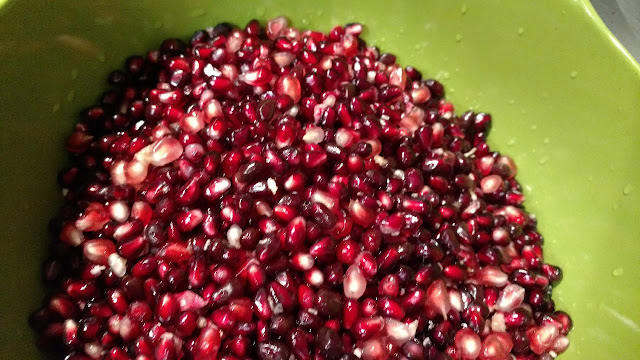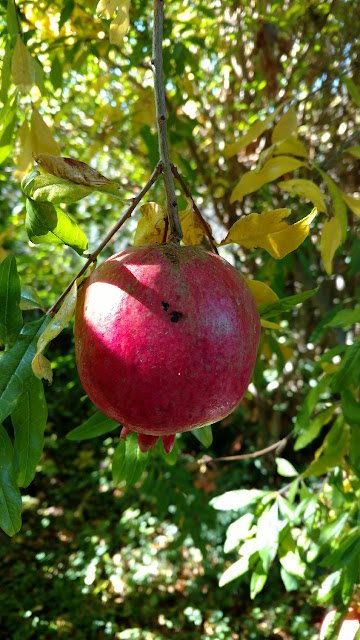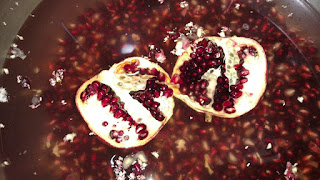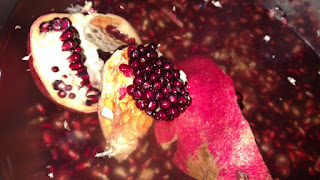
|
|
It took a lot of work to produce this bowl of pomegranate arils from a pomegranate harvest. (Photos: Debbie Arrington)
|
How to get the most out of a pomegranate, from pruning to deseeding

|
|
Pomegranates can be left on the tree
after the leaves drop off. They're
ready when they look blocky, not round. Cut them
off with pruning shears.
|
Every December, I see red. In particular, I see dots of bright red juice on counters, cabinets, walls and more.
Despite my best efforts, pomegranate processing always leaves my kitchen looking like a crime scene, although I've found some tricks to minimize the splatter zone.
After 30 years of home-grown pomegranates, it wouldn't be Christmas without fresh grenadine or cheery red jelly. But juicing this unusual and ancient fruit takes some planning and effort, especially if the tree has a good year.
Pomegranates are one of the best edible ornamentals for the California garden. They add beauty in three seasons. In spring, they're covered with shiny emerald foliage and brilliant orange blooms. In late summer, the large red globes form on its willowy branches. In October and November, the colorful fruit keeps hanging and ripening as the foliage turns to autumn gold.
Pomegranates will cling to the tree long after the leaves are gone. Other trees will drop their fruit at some point, but not pomegranates. The fruit has to be cut off (preferably with sharp bypass pruners).
That's part of the pomegranate puzzle; knowing when to pick. Most commercial growers pick them under-ripe to avoid splitting or other damage. When the round fruit turns blocky, the arils (the seed sacs) are at their juiciest. That's when I bring them in, usually around Thanksgiving.

|
|
The calyx on top must be removed first.
|
Off the tree, pomegranates will keep several weeks. In the refrigerator crisper, they'll last three months or more. They'll actually produce more juice after they've sat a couple of weeks.
By that time, the leathery skin can start to harden. If so, soak the whole fruit for 5 to 10 minutes in lukewarm water before deseeding.
The best way to remove arils from a pomegranate is under water. Fill a large bowl half full with cold water. With a sharp paring knife, remove the calyx -- the little pointy crown opposite the stem end. Without its top, the sections and natural seams of the pomegranate are easier to see.
Score the outside skin along one or two of those sections (this is where the splatter happens as some juice escapes). Then, submerge the fruit under the water in the bowl. Carefully pull the halves of the pomegranate while it's underwater, teasing apart the sections. Once separated, the sections can be turned inside out, exposing dozens of plump seed sacs.

|
|
Pull the scored halves apart under water in a large bowl.
|
Your fingers are the best tool to remove those arils without breaking them open. Gently run them out of place under water. The arils sink to the bottom while the white membrane that holds them in place floats to the top. All that white debris can be skimmed off, then the arils drained for use as is or juiced.
Remember to wash your hands well after working with pomegranates; the red juice stains skin bluish black. Or wear thin gloves.

|
|
Use your fingers to release the arils from the membrane.
|
As for the tree, December and January are prime pomegranate pruning time. Actually a large shrub, pomegranates can be trained to a single trunk or a more natural (and fruitful) three to six trunks. In pruning, open up air circulation in the center of those multiple trunks; that allows for more flowering and more fruit. Otherwise, all the fruit will be on the outside of the tree.
Avoid hard pruning pomegranates or expect a year with no fruit. Pomegranates bear fruit on second-year wood, sprouts the tree produced the previous year. If you remove all the new growth each winter, the pomegranate will have few if any fruit.
After processing a big box of pomegranates, I sometimes think that's not such a bad idea.





